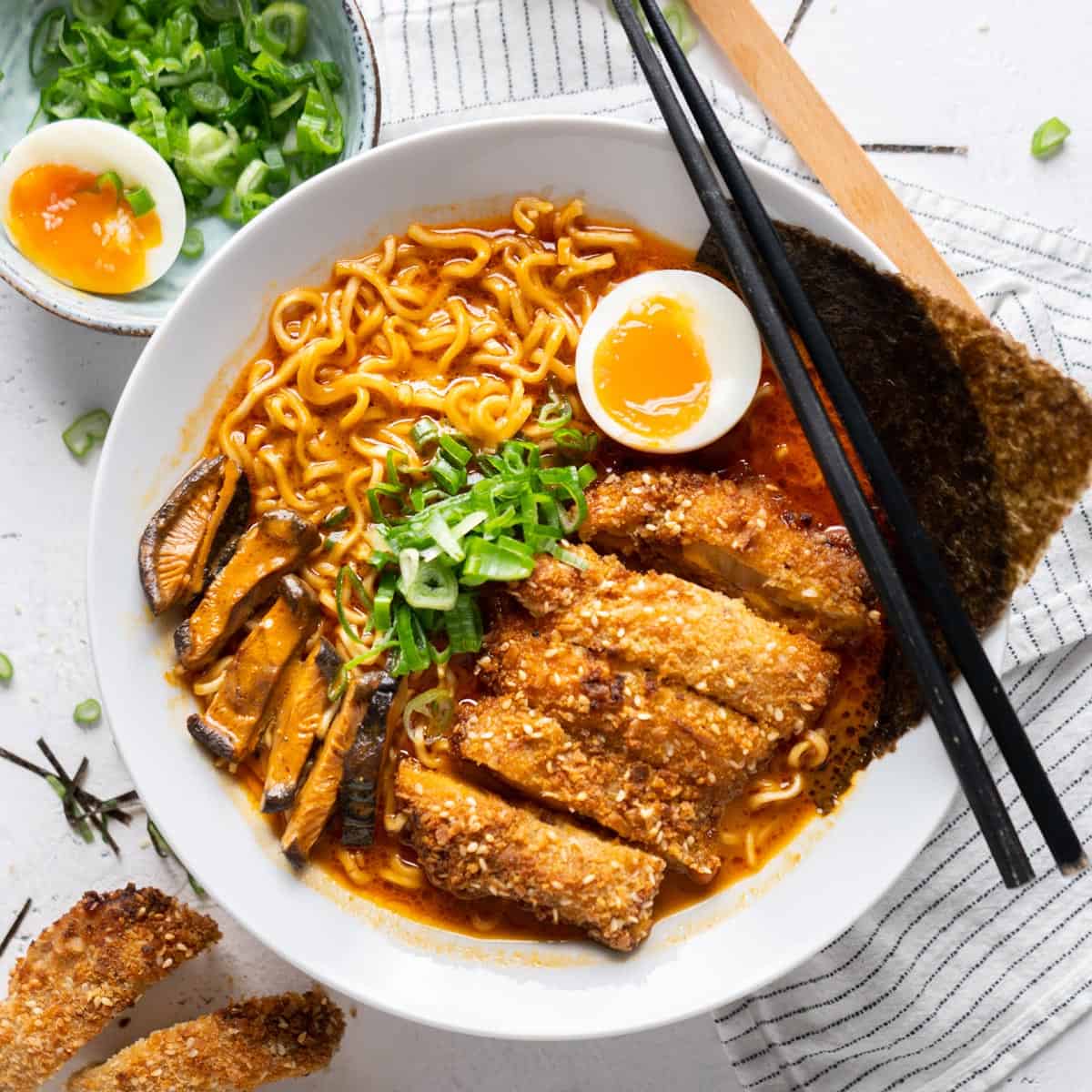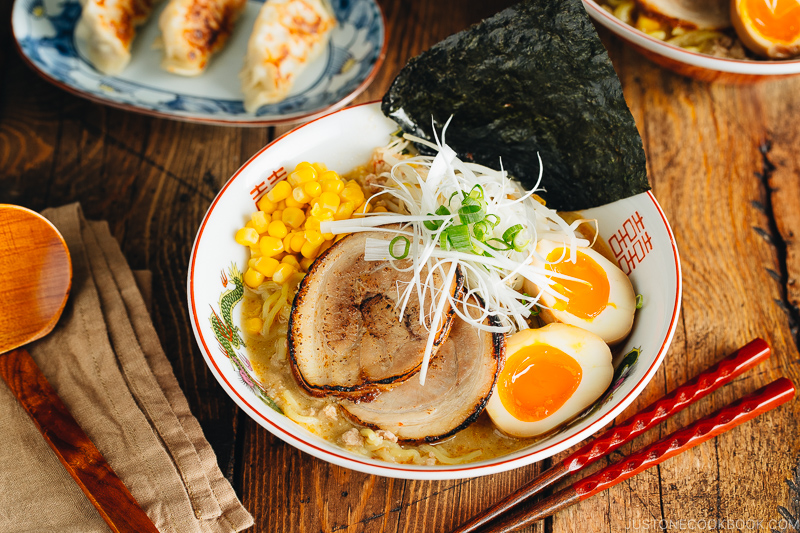Japanese Lemongrass, Chicken, and Ginger Ramen is a delightful fusion of flavors that combines the aromatic essence of lemongrass, the savory richness of chicken, and the warm spiciness of ginger. This unique ramen recipe takes your taste buds on a journey with its vibrant and refreshing flavors.

Japanese Lemongrass, Chicken, and Ginger Ramen
Ingredients
Equipment
Method
- Add all the ingredients of the sauce i.e. miso paste, soy sauce, mirin paste and Japanese fresh herbs into a large pan.
- Add the shredded chicken meat, lemongrass, ginger slices, tomato paste, chopped tomatoes and the rest of the ingredients into the mixture
- Cook the dish for ten minutes.
- Add the ramen into the mixture once the sauce is ready.
- Mix the ramen well.
- Cook the dish for five minutes.
- Add the cilantro and the green onions into the dish.
- Your dish is ready to be served.
Video
Notes
Some frequently asked questions (FAQs) about Japanese Lemongrass, Chicken, and Ginger Ramen:
1. Can I use dried lemongrass instead of fresh?
– While fresh lemongrass provides the best flavor, you can use dried lemongrass if fresh is not available. Use about half the amount of dried lemongrass compared to fresh, as the flavor is more concentrated.
2. Can I substitute chicken with another protein?
– Yes, you can customize the recipe by using other proteins such as shrimp, tofu, or thinly sliced beef. Adjust the cooking time accordingly to ensure proper cooking.
3. How can I adjust the spiciness level?
– If you prefer a spicier ramen, you can add red chili flakes or chili paste to the broth during the simmering process. Adjust the amount according to your desired heat level.

4. Can I make the broth in advance?
– Yes, you can make the lemongrass and ginger broth in advance and store it in the refrigerator. Reheat it when ready to serve and adjust the seasoning if needed.
5. Can I use pre-packaged ramen noodles?
– While pre-packaged ramen noodles can be used in a pinch, they may not have the same texture or flavor as fresh ramen noodles. If using pre-packaged noodles, follow the package instructions for cooking.
6. Can I add additional vegetables to the ramen?
– Absolutely! Feel free to add vegetables like bok choy, mushrooms, or spinach to the ramen. You can blanch or sauté them separately and add them to the assembled ramen bowls.
7. Can I make a vegetarian version of this recipe?
– Yes, you can make a vegetarian version by using vegetable broth instead of chicken broth and omitting the chicken. Add tofu or other plant-based proteins for added substance.
8. How long should I simmer the chicken in the broth?
– Simmer the chicken in the broth for about 20-25 minutes or until it is fully cooked and tender. Ensure that the internal temperature of the chicken reaches 165°F (75°C).
Remember to adjust the recipe to suit your preferences and dietary needs. These answers should provide guidance as you embark on your culinary journey to create a delicious bowl of Japanese Lemongrass, Chicken, and Ginger Ramen. Enjoy the process and savor the flavors!
Cooking tips
Here are some cooking tips to help you achieve the best results when making Japanese Lemongrass, Chicken, and Ginger Ramen:
1. Use fresh ingredients: Whenever possible, use fresh lemongrass, ginger, and other ingredients for optimal flavor. Fresh lemongrass adds a vibrant citrusy aroma, while fresh ginger provides a warm and spicy kick.
2. Properly prepare lemongrass: To extract the maximum flavor from lemongrass, trim off the tough outer layers and use only the tender inner part. Bruise the lemongrass stalk with the back of a knife or a mallet to release its essential oils before adding it to the broth.
3. Infuse the broth: Allow the lemongrass and ginger to simmer in the broth for at least 30 minutes to infuse their flavors into the liquid. This step enhances the overall taste of the ramen.
4. Adjust seasoning: Taste the broth as it simmers and adjust the seasoning accordingly. You can add more soy sauce, salt, or a dash of fish sauce to enhance the umami flavors. Balance the flavors by adjusting the amount of lime juice for a subtle tanginess.
5. Cook the chicken thoroughly: Ensure that the chicken is fully cooked through before serving. Use a meat thermometer to check that the internal temperature reaches 165°F (75°C). Overcooking the chicken can result in dry and tough meat.

6. Cook noodles separately: Cook the ramen noodles separately from the broth. This allows you to control their doneness and prevents them from becoming overly soft or mushy when mixed with the hot broth.
7. Use tongs to handle noodles: When transferring the cooked noodles from the boiling water to the serving bowls, use tongs to prevent them from clumping together. Gently shake off excess water before placing them in the bowls.
8. Customize toppings and garnishes: Feel free to add your favorite toppings and garnishes to enhance the ramen’s taste and visual appeal. Sliced green onions, cilantro, bean sprouts, and a sprinkle of sesame seeds are popular choices. You can also add a soft-boiled egg, sliced mushrooms, or a drizzle of chili oil for extra flavor.
9. Serve immediately: Ramen is best enjoyed when served immediately after assembly. This ensures that the noodles are still firm and the broth is hot. Delaying serving may result in the noodles becoming soggy.
10. Experiment and adjust: Don’t be afraid to experiment with the recipe and adjust it to your taste preferences. Add more or less ginger and lemongrass according to your desired intensity of flavors. The beauty of homemade ramen is the ability to tailor it to your liking.
By following these cooking tips, you’ll be on your way to creating a delicious bowl of Japanese Lemongrass, Chicken, and Ginger Ramen that showcases the vibrant flavors of the ingredients. Enjoy the process and savor the delightful combination of aromas and tastes!
Serving
When it comes to serving Japanese Lemongrass, Chicken, and Ginger Ramen, here are some serving suggestions to enhance your dining experience:
1. Individual Bowls: Serve the ramen in individual bowls to create a personalized and visually appealing presentation. Make sure each bowl contains a generous portion of noodles, chicken, and flavorful broth.
2. Garnish Galore: Offer a variety of garnishes and toppings on the side for each person to customize their ramen. Some popular options include thinly sliced green onions, fresh cilantro leaves, bean sprouts, lime wedges, and sliced red chili peppers. Place these toppings in small bowls or plates on the dining table for easy access.
3. Ramen Eggs: Consider serving ramen eggs, also known as ajitsuke tamago, alongside the ramen. These soft-boiled eggs marinated in soy sauce and other seasonings add a creamy and savory element to the dish.
4. Pickled Vegetables: Offer a side of pickled vegetables, such as pickled ginger, cucumber, or radishes. These tangy and crunchy additions provide a refreshing contrast to the rich flavors of the ramen.
5. Condiments on the Table: Provide condiments such as soy sauce, chili oil, and sesame seeds on the table. This allows individuals to adjust the seasoning and spice level of their ramen according to their preference.

6. Side of Asian Greens: Serve a side dish of blanched or sautéed Asian greens, such as bok choy or Chinese broccoli. These nutritious and vibrant greens complement the ramen and provide a refreshing element to the meal.
7. Japanese Tea: Offer a selection of Japanese teas, such as sencha or genmaicha, to accompany the ramen. The earthy and aromatic flavors of these teas pair well with the rich and complex flavors of the dish.
8. Enjoy with Chopsticks and Spoons: Provide chopsticks and spoons for an authentic dining experience. The chopsticks are ideal for picking up noodles and toppings, while spoons are perfect for savoring the flavorful broth.
9. Family-Style Sharing: Consider serving the ramen family-style, with large bowls of noodles, chicken, and broth placed in the center of the table. This encourages interaction and allows everyone to help themselves to their desired portions.
10. Experiment with Additional Toppings: Feel free to experiment with additional toppings such as sliced shiitake mushrooms, seaweed strips, or even a sprinkle of furikake (Japanese seasoning). These additions can add depth and variety to the ramen.
Remember to set the table with necessary utensils and napkins for a convenient dining experience. With these serving suggestions, you can create an enjoyable and customizable dining experience with Japanese Lemongrass, Chicken, and Ginger Ramen.








